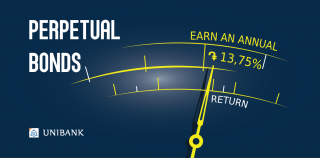
President of Iran conveyed his key message
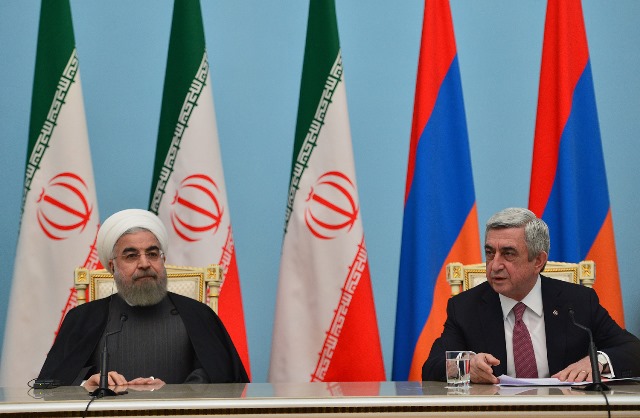
Long-awaited official visit of Hassan Rouhani, president of the Islamic Republic of Iran, to Armenia started with the most important and the only message addressed to the Armenian authorities. On his way to Armenia, Rouhani told reporters in Tehran’s Mehrahabad international airport that Iran may connect the Black Sea and Europe through Armenia.
As compared to the Armenian authorities, which exert efforts to join Iran to Eurasian Economic Union (EEU), to which Iran isn’t against, the Iranian side proposes more global transport, economic projects to Armenia, in response to which Armenian president Serzh Sargsyan stated during Armenia-Iran Business Forum that Armenia may be a gate and additional transport corridor for Iran and EEU, by connecting the Persian Gulf to the Black sea through the North-South Corridor. However, it’s worth starting from the very beginning of the visit.
A few-hour visit of Hassan Rouhani to Armenia started in the airport by the ceremony of official welcoming with the participation of Armenian president Serzh Sargsyan, which was followed by participation of enlarged company of official delegations of the two countries.
In the end of Armenia-Iran high-level negotiations documents of deepening bilateral cooperation in several fields have been signed between the Republic of Armenia and the Islamic Republic of Iran. After the negotiations the presidents appeared with statements.
“As a result of the agreement reached by the Republic of Armenia and Islamic Republic of Iran the swaps of natural gas and electrical energy between us continue. Taking into consideration the necessity to provide for the necessary volumes, which stems from the mentioned above swaps and quadripartite agreements reached in Yerevan, we have also spoken about the use of the Iran-Armenia-Georgia-Russia energy corridor.
We have also exchanged views on the program related to the establishment of a Persian Gulf-Black Sea transport and transit corridor, which will facilitate the transportation of international cargo, will provide the opportunity for the Iranian goods to enter the European market at the minimal transportation cost, as well as will allow to use it as a transit route for cargos from other countries. This will be not only the shortest and the safest passage via Armenia for the Iranian vehicles but will also become a very serious impulse for the growth of the turnover between our countries,” Armenian president said in his statement.
The part of Rouhani’s statement, where he reconfirmed Iran’s position in NK conflict, was rather noteworthy. “For us Armenia and Azerbaijan are partners. We want to see peace, which will be in favor of the whole region. The issue doesn’t have military solution,” Rouhani said.
Armenian messages addressed to the Iranian side were heard during Armenia-Iran Business Forum. Hovhannes Azizyan, Deputy Minister of Economic Development and Investments, told reporters that the Forum is rather useful from the perspective of developing business cooperation between Armenian and Iranian businessmen. Thus, in his words, they anticipate that this will provide the opportunity to increase trade turnover and volume of bilateral investments of the two states.
He informed that during the Forum the issue of establishing joint enterprises will be touched upon, which will provide the opportunity to the producers exporting goods to Iran, and Iranian producers—to EEU countries, where Armenia has preferential trade regime.
He also informed that this project, in all likelihood, will become a reality by the end of the forthcoming year. Aram Vardanyan, representative of the Ministry of Economic Development and Investment, introduced the project at the Forum, who stated that the third economic zone for Armenia will be built in Agarak, where a 37 hectares area has been chosen, on which 10-15 hectares free zone will be built.
According to Vardanyan, if this project succeeds, upon anticipations of the Armenian side, in the period of 10 years this one will attract around 120 enterprises, average export volumes per year will comprise USD 80-100 million, GDP investments—USD 350-400 million, more than 2500 workplaces will be established. Vardanyan also added to which markets the goods will be exported. It refers to Iran, EEU member countries, Middle East countries—UAE, Kuwait, Qatar, Turkmenistan.
“The main fields, which will be proper in that area, have been singled out: processing of food, industry, machinery, electronics, chemical industry, textile production, pharmacotherapy and etc.,” Aram Vardanyan said. Arsen Ghazaryan, President of Union of Manufacturers and Businessmen (Employers) of Armenia, also stressed on this probability, as well as on what the Armenian side anticipates from Armenia-Iran trade and economic relations.
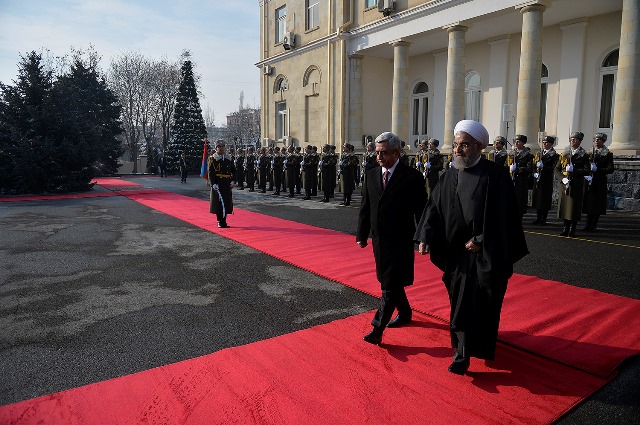
“Being a small market, Armenia is a partner with a rather serious potential for Iran’s investors both from the perspective of working in the Armenian market, and appearing in Eurasian market, Europe, the USA by establishing joint enterprises. Why with us? Because we have a rather interesting regime, we are an EEU member, our customs duties aren’t applied, we have GSP+ in Europe and GPP system in the USA.
No matter how soft sanctions against Iran will be, which is an implication of slow processes, Iran, as a big market, won’t have the statuses, these regimes, which are provided to Armenia by the transit country and neighboring program. By producing goods, packing in Armenia, the potential is big to compete and win by making use of favorable customs and tax regimes in other markets. We intend to do this and we seem to succeed in attracting big investors to Armenia besides small and medium ones,” Ghazaryan said.
However, not all Iranian businessmen yet realize what proposal Armenian side is making. Several businessmen complained to “168 Hours” of high customs duties and absence of reliability of Armenia’s investment field. The question was raised during the Forum as well, in response to which Garegin Melkonyan, First Deputy Minister of Economic Development and Investments, assured that customs duties for Iranian businessmen are lower, than in Iran. He urged to speak by concrete examples.
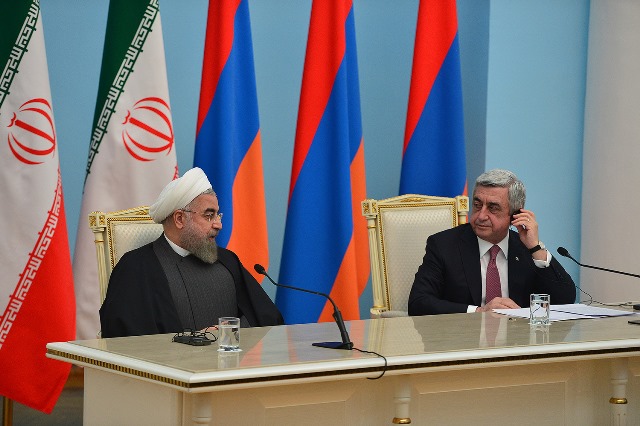
In his speech Garegin Melkonyan stated that Armenia may be attractive to foreign investors despite its small market, as it has open economic field and favorable conditions. According to him, Iranian businessman, organization makes use of the same conditions for starting a business in Armenia, as the Armenian businessman, moreover, there are no restrictions. “Goods produced in Armenia are freely exported to EEU member countries without customs formulations,” the Deputy Minister said, touching upon the possibilities of free economic zone.
Gholamhossein Shafei, Chairman of Iran’s Chamber of Commerce, Industries, Mines and Agriculture, told “168 Hours” that Iranian businessmen are interested in free economic zone, who still study the opportunities provided by the zone. According to him, it may become a crucial project, in particular, under availability of Iran-Armenia-EEU trade and economic cooperation perspective.
“Why not? Iranian businessmen would like to make use of this opportunity, if it’s finalized,” he said, adding that Armenia-Iran business, trade and economic ties should be complied with the level of political relations. During the Forum businessmen had the opportunity to have B2B meetings, after which Armenian president Serzh Sargsyan and Iranian president Hassan Rouhani appeared with concluding remarks.
Serzh Sargsyan stated that relations between Iran and Armenia hold a great potential; however, until now only part of it has been used, thus, it’s necessary to make our trade and economic relations comparable to Armenia-Iran high-level political relations, which will provide the opportunity to bring into life big economic projects. “Today I asked the president of Iran to encourage big businessmen in all the fields to come to Armenia and initiate a business here, promising myself to encourage Armenian businessmen to do the same in the Islamic Republic of Iran,” the president said, assuring that he will personally control that process. Sargsyan stated that Iranian capital should be more visible in Armenia, for which all preconditions have been established. From the advantages of investing in Armenia he stressed the circumstance, that our country has preferential trade regime for many countries, meaning GSP, GSP+ systems and privileges conditioned by membership to EEU.
In his turn, Rouhani stated that one of the axes of his visit to Armenia is the development of Iranian gas export, its enlargement to Armenia. According to him, the first step has been taken for better relations between the two nations, meaning launch of Iranian gas supply in Meghri and Agarak.
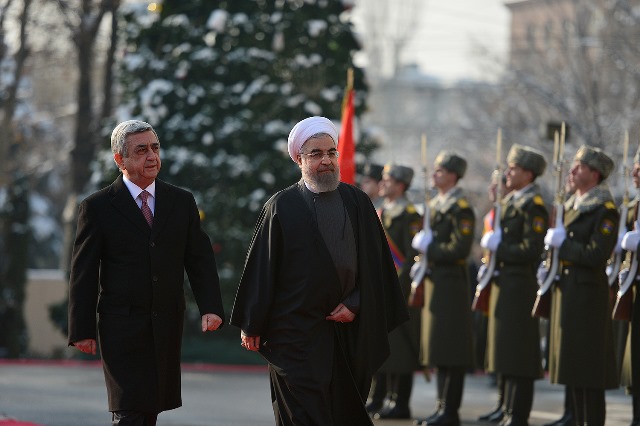
“The next step to implement is banking relations between the two countries, and they should activate. The third circumstance, which we should pursue, is customs and tax relations, our customs offices should contribute to transportation of goods and guarantee them. We hope that step will be implemented.
Fortunately, Iran’s custom house designed special conditions for Armenia and it may foster economic relations. The next circumstance, necessary for bilateral relations, is productive use of free economic zone. It may facilitate relations of the two states.
Geographical positions of Iran and Armenia are also important, as well as North-South transit corridor. It is possible to link the Black Sea to the Persian Gulf through highways and railways which will create favorable trade and economic conditions for the states of our region and beyond it.
We don’t observe any obstacles, the security available in Armenia and Iran, is of paramount importance. It’s a good ground for economic cooperation. We should take steps toward preferred tariffs and trade between both Iran and Armenia, as well as Iran and EEU, a member of which is Armenia, and soon a convention will be held, and we hope that the first step between Iran and EEU will take place for preferred trade,” Rouhani said.
Visit of Iranian president to Armenia, bilateral statements made during those several hours, caused a big stir among political and expert circles, because as a result of the visit, basically, the circle of expectations related to Armenia-Iran relations was clearly shaped. And time will show what reflection those quite different expectations will have, in which volume and how they’ll be implemented.
By Araks Martirosyan







